If you want a concise answer right away: the best ebike size for most commuters is one with a frame and wheel combination that gives a natural standover with about 1–2 inches (2.5–5 cm) clearance, a comfortable reach that lets you ride upright without shoulder strain, and wheel size matched to your route (27.5"–29" for speed/comfort, 20"–26" for compact storage/urban agility). In short, choose fit first, wheel size second, and accessories third.
This guide, What’s the Best Ebike Size for Commuters?, explains how to translate those rules into a practical purchase and fit routine so you won't be guessing at the shop or stuck with a bike that rides poorly after your third commute.
Understanding ebike sizing basics
Ebike sizing borrows a lot from traditional bicycle fitting, but there are key differences—motor placement, battery integration, and added weight change how geometry feels under power. When you’re deciding “what’s the best ebike size for commuters,” understanding the three core elements — frame geometry, standover, and reach/stack — gives you the vocabulary to evaluate every model.
Frame geometry 101
Frame geometry describes numbers on paper: top tube length, seat tube angle, head tube length, chainstay length and so on. These control wheelbase, handling, and posture. For commuting:
-
A slightly relaxed geometry (taller head tube, shorter reach) favors upright posture and visibility.
-
A slacker head angle and longer wheelbase improve stability when carrying cargo.
-
Short chainstays make the bike more nimble for tight city turns.
When you test-ride an ebike, ask for the geometry chart and compare it to bikes you've ridden. If a bike feels cramped or stretched, geometry numbers will explain why.
Standover height and safety
Standover height is the distance from the ground to the top tube where your crotch meets the bike when standing over it. For commuters you want 1–2 inches (2.5–5 cm) clearance at a minimum (more if you plan to hop off quick). Why? Because urban rides mean frequent stops, dodges, and parking in tight spots — you need to be ready to put a foot down safely.
👉 The VICTRIP Mimas Step-Through eBike is a great example — its low-step frame design and adjustable seatpost make it ideal for riders of all heights, especially for short-stop commuting or frequent mounting and dismounting.
TOP PICK
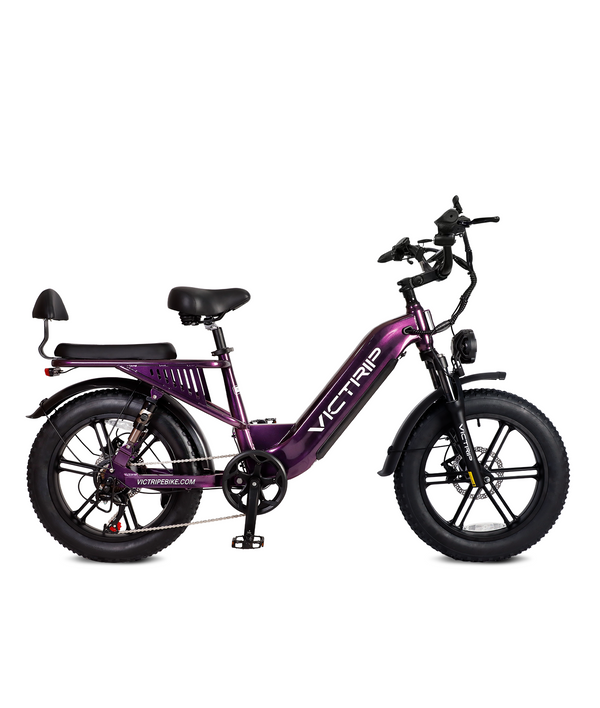
VICTRIP® Mimas Electric Bicycles With Torque Sensors
Reach, stack and riding posture
Reach is how far forward you extend to the bars; stack is how tall the front of the bike is. Together they determine posture. For commuting, prioritize stack (taller front end) so you can see traffic and not strain your back. Reach can be adjusted with stem length and handlebar sweep, but only within limits.
If you’re taller or prefer a forward-leaning position, the VICTRIP SURNAT N12 offers a balanced reach-to-stack ratio with wide handlebars and ergonomic grips, allowing for extended rides without shoulder fatigue.

Wheel size and ride characteristics
Wheel size is often the most visible spec—yet it’s also one of the most misunderstood. Different wheel diameters change acceleration, stability, and how the ebike negotiates potholes or curbs.
Compact wheels: agility vs roll-over
Smaller wheels (16"–20" common on folding ebikes) accelerate quickly and make the bike incredibly maneuverable. They’re brilliant if you:
-
Need a folding bike for transit or storage.
-
Ride in very congested urban environments.
-
Value quick acceleration from stops.
But small wheels can feel choppy on rough pavement and don’t roll over obstacles as smoothly. For a daily commuter covering longer distances, they can be tiring over time.
Mid and large wheels: speed and comfort
26", 27.5", and 29" wheels roll smoother and keep momentum, which reduces effort on longer commutes. They handle bumps better and often pair with wider tires for comfort and puncture resistance. If your route includes long stretches, commuter bike lanes, or rough roads, larger wheels generally make the ride more pleasant.
Trade-off: Larger wheels are less packable and can make the bike feel bigger in tight traffic. Also, larger wheels + big battery = weighty bike—so plan accordingly.
What’s the Best Ebike Size for Commuters? — Quick answer
Right up front — and to place the keyword where it belongs — What’s the Best Ebike Size for Commuters? The best size is the one that matches your body geometry and your commuting context:
-
If you’re 5'2"–5'8": look for medium or small frames with wheel sizes from 26" to 27.5" or compact 20" folding models if you need transit compatibility.
-
If you’re 5'9"–6'1": medium or large frames, typically 27.5"–29" wheels work best.
-
If you’re 6'1"+: large or extra-large frames with 29" wheels or adjustable geometry to ensure torso reach is comfortable.
Above all, fit beats spec. Don’t let a flashy battery or motor blind you: if the bike doesn’t put you in a natural, comfortable position, it’s not the right size.
Read More: Ebike Frame Size Guide: Finding Your Perfect Fit.
Matching your body to the ebike
Sizing isn’t just a function of your height; inseam length, torso length, arm length and flexibility all matter. Two people both 5'10" can require different frames. Here’s a practical way to size yourself.
Height-to-frame-size conversion charts
Most brands publish a size chart — use it as a starting point. As a rule of thumb:
-
Under 5'3" (160 cm): XS or small frame (often 26" or 27.5" wheels or a compact 20" folding frame).
-
5'3"–5'8" (160–173 cm): Small–Medium frame.
-
5'9"–6'1" (175–185 cm): Medium–Large frame.
-
Over 6'1" (185+ cm): Large–XL frame.
But here’s the important bit: measure your inseam (crotch to floor) and add 9–11 inches (23–28 cm) for approximate frame size in traditional bikes. For ebikes, because frames vary widely, use the manufacturer’s reach/stack numbers and try to match reach to your arm length.
Special cases: long legs, long torso
If you have long legs but a short torso, you might want a smaller frame with a longer seatpost and shorter stem. Conversely, long torso + short legs often needs a longer top tube and longer reach — or an adjustable stem.
Practical commuter factors beyond pure size
When you’re asking “what’s the best ebike size for commuters,” don’t forget how you’ll use the bike. These practical considerations often tip the balance.
Rack, fenders, and gearing compatibility
If you commute with a laptop, groceries, or a change of clothes, you’ll want a bike with a sturdy rear rack and space for full fenders. Some small frames don’t accommodate racks or full-size fenders. Check mounting points and clearance before buying.
Gearing matters too: heavy hub-motor bikes need lower gearing for hill starts. If you expect to carry cargo, ensure the drivetrain has a low enough gear and that wheel size won’t make climbing awkward.
Motor placement and battery size
Mid-drive motors change frame geometry and weight distribution less than hub motors, often yielding more natural handling. A rear hub motor increases unsprung mass and can alter balance—especially on lighter frames. Larger batteries increase range but add weight; sometimes choosing a moderately-sized battery and carrying a spare charger is a smarter move for city commuting.
The VICTRIP Titan S’s mid-drive layout and high-capacity 48V 60AH battery give excellent stability and range for longer commutes.
TOP PICK
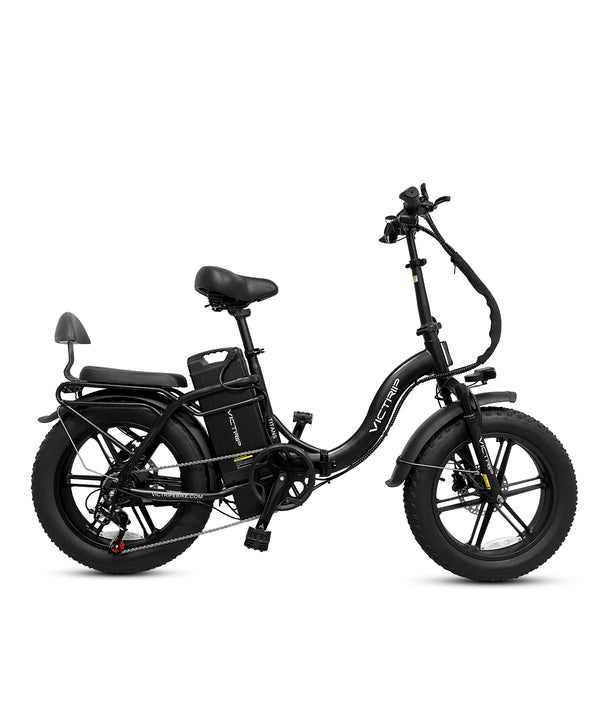
VICTRIP®TITAN S 1000W Ebike
Test-ride checklist and fitting steps
A test ride is where everything clicks. Use this checklist so you don’t miss anything in the moment.
What to measure on the bike
-
Standover clearance: 1–2 inches (2.5–5 cm) min.
-
Saddle height range: Can it be raised enough for full-leg extension with slight knee bend (~25–35°)?
-
Reach: At rest, elbows slightly bent, shoulders relaxed.
-
Handlebar height: Tall enough for clear sight lines.
-
Wheel size feel: Does curbing and pothole crossing feel stable?
Real-world test-ride drills
-
Accelerate from a full stop and check stability.
-
Take a tight S-turn at slow speed to test low-speed handling.
-
Simulate a loaded state: if possible, test with a rear rack bag or pannier.
-
Brake hard to evaluate stopping distances under load.
If a bike feels awkward during any of these tests, try adjusting stem length or saddle position before dismissing it — but know that geometry limits what adjustments can fix.
Adjustments and accessories to perfect fit
Even a well-sized frame benefits from final tweaks.
-
Stem swaps let you fine-tune reach; shorter for a more upright position, longer for stretched-out speed.
-
Handlebar rise/sweep changes wrist angle and uprightness.
-
Suspension seatposts and ergonomically shaped saddles reduce urban-bump fatigue.
-
Tire width: wider tires (2.0"–2.4") add comfort; narrower tires roll faster.
Remember: many shops will fit these adjustments for a fee, and small changes can dramatically change ride experience.
Sizing for special commuter types
Some commuters have specific needs:
-
Cargo riders need longer wheelbase frames, robust racks, and possibly mid-drive motors for torque.
-
Short riders may prefer step-through frames for easy mounting/dismounting.
-
Multi-modal commuters who fold bikes for trains want compact wheel sizes and quick-release hardware.
Decide which category you fall into and prioritize those frame features first.
Maintenance and long-term comfort
Correct sizing reduces wear: an improperly sized bike leads to over-extension (worn knees), back strain, and premature component stress. Regularly check torque on rack mounts, wheel spokes and brakes — heavier ebikes transmit more stress into those components. A well-sized ebike will feel more efficient and request fewer adjustments down the line.
The VICTRIP R6 Pro is heavy-duty frame and hydraulic brakes make it ideal for heavier commuters who ride daily and need durable performance over time.

Buying used vs new: sizing tips
Buying used can save money, but sizing mistakes are costly. When evaluating a used commuter ebike:
-
Verify standover, saddle height range, and that the seatpost isn’t maxed out.
-
Check battery health (ask for cycle count if available).
-
Inspect frame for weld cracks near motor mounts and battery tray.
-
Take the bike on your usual route if possible to ensure fit in context.
Quick buyer’s checklist
-
Standover clearance: 1–2 in (2.5–5 cm)
-
Comfortable reach with slightly bent elbows
-
Wheel size matched to route (20" folding for transit, 27.5"/29" for longer rides)
-
Rack/fender compatibility if you commute with gear
-
Test-ride for acceleration, braking, and low-speed handling
-
Confirm service and spare parts availability
Conclusion & expert takeaways
What’s the best ebike size for commuters? The answer isn’t a single number — it’s a process. Prioritize a frame that fits your body geometry (standover, reach, stack), choose wheel size based on your route and storage needs, and test-ride loaded and unloaded when possible. Remember: fit beats spec. A properly sized ebike will feel safer, more efficient, and more enjoyable — and you’ll ride it more often.
For further reading on fit and safety, reputable cycling publishers offer excellent sizing primers (for example, Bicycling Magazine’s fitting guides and manufacturer geometry charts can be useful starting points).
FAQs
What’s the best wheel size for a 10-mile commute?
For most 10-mile commutes, 27.5" or 29" wheels deliver a comfortable ride with efficient rolling resistance. If you need to fold or carry the bike on transit, a 20" folding model may be better though it sacrifices roll-over comfort.
Can I change an ebike’s frame size by swapping stem or seatpost?
You can adjust reach and handlebar height using stem swaps and seatpost changes, but these are fine-tuning measures — they can’t fix a frame that’s fundamentally too long or too short.
How much standover clearance is safe for city commuting?
Aim for at least 1–2 inches (2.5–5 cm) to allow quick, confident dismounts at traffic stops and when dodging hazards.
Are mid-drive or hub-drive motors better for commuter fit?
Mid-drive motors tend to centralize mass and preserve handling; hub motors can add unsprung mass but may be cheaper. Choose based on handling preference and maintenance access.
Should I prioritize battery capacity over frame fit?
No — fit should come first. A comfortable bike that you ride daily with a modest battery will be more valuable than an ill-fitting bike with 100+ mile range you rarely use.
What adjustments help tall riders (6’2"+) fit smaller frame ebikes?
Taller riders can use longer seatposts, longer stems and higher-rise handlebars, but beware of exceeding seatpost minimum insertion—if the post is near its max, opt for a larger frame to avoid safety risks.

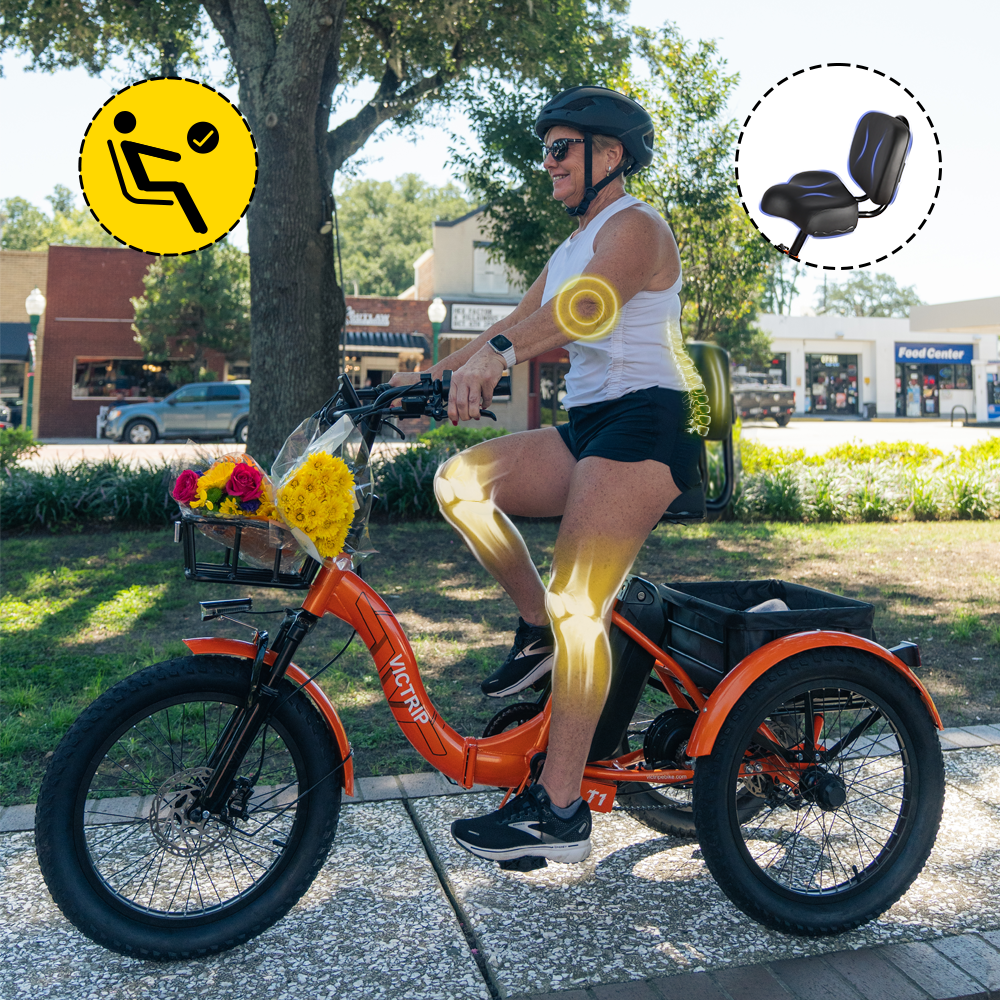
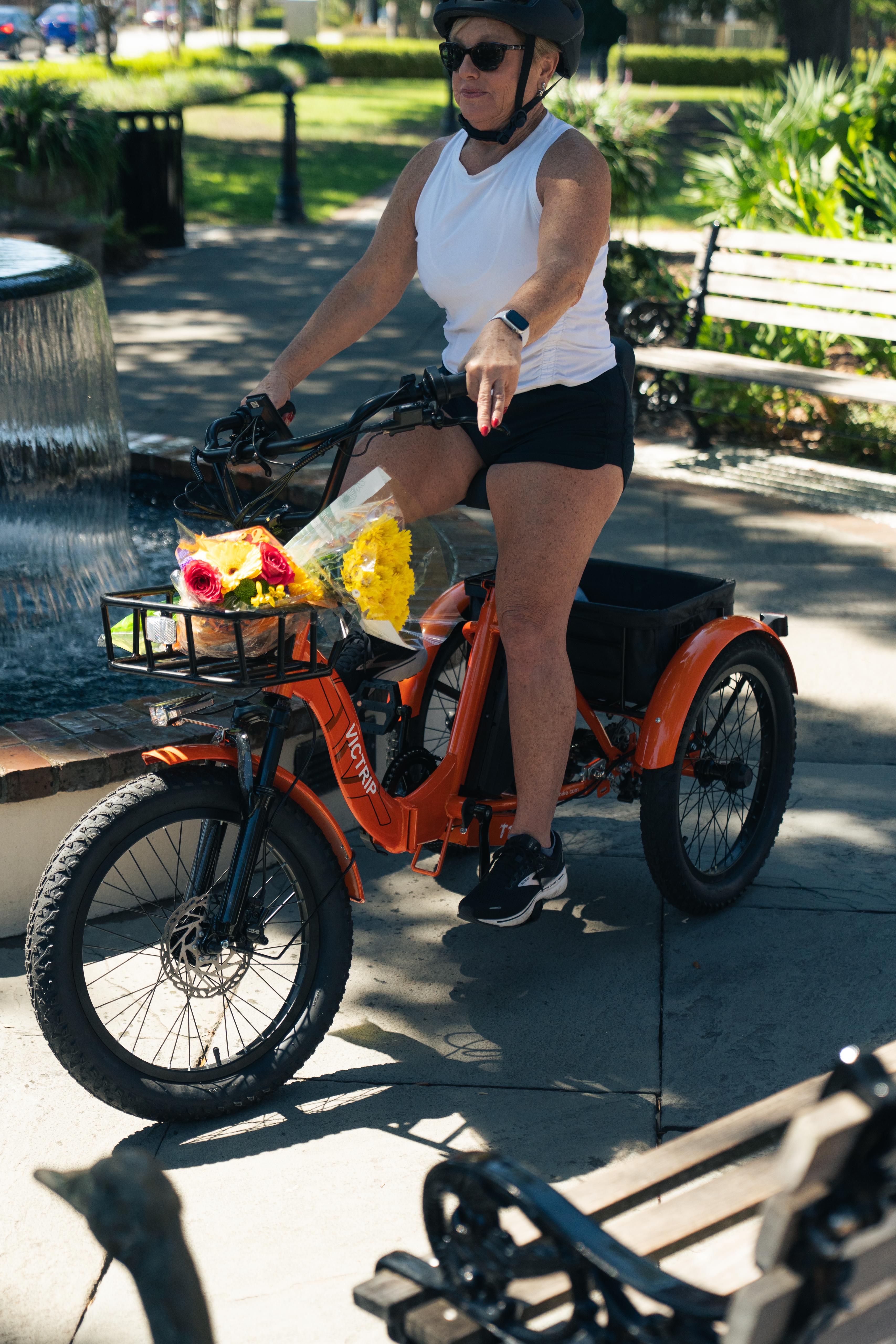
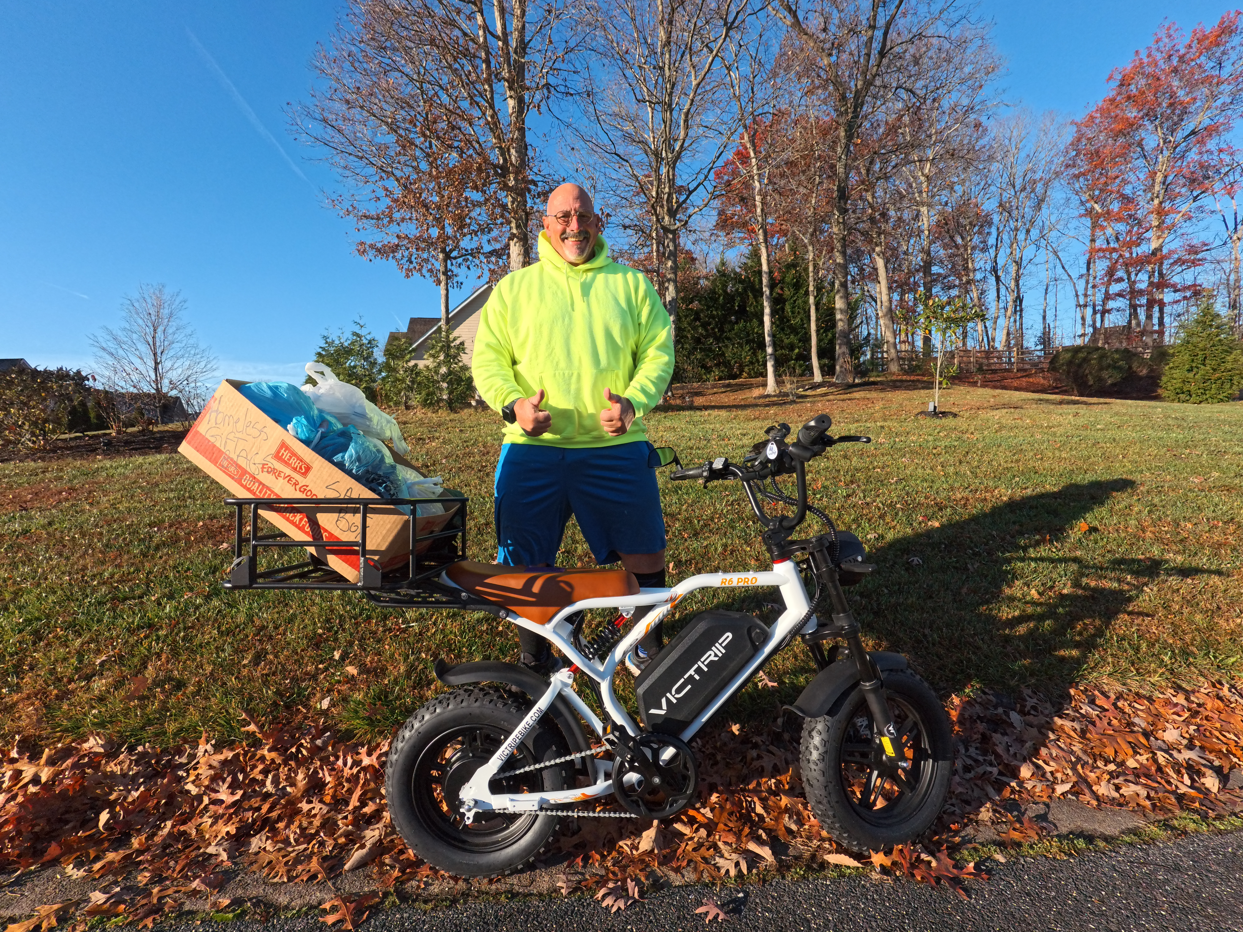
Share:
E-bike Battery Care During Winter: Everything You Need to Know
Gas vs Electric Off Road Bikes: Which One Should You Ride?